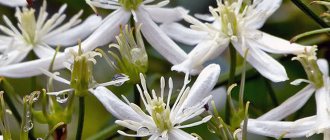Author: Natalya Category: Garden plants Published: October 11, 2016Republished: February 12, 2019Last edits: January 20, 2021
- Soil for crocuses
- Caring for crocuses in autumn
In summer cottages, crocuses are one of the most popular spring flowers, although there are species and varieties that bloom towards the end of summer. These flowers are used for alpine slides. Crocuses in the flower garden go well with other early spring flowers - muscari, primrose and scylla. Crocuses are unpretentious, resistant to natural conditions and reproduce very quickly. Our website has already posted an article about growing crocuses, but today we will tell you about when to dig up crocus bulbs after flowering, where and how to store them, and when to replant crocuses in the ground in the fall.
When to plant crocuses in the ground in the fall
Landing dates
The timing of planting crocuses depends on what time of year you want to see them bloom. For autumn flowering, the optimal time to plant crocuses is from June to early August. And spring-blooming crocuses are planted before winter.
When to plant crocuses in open ground in the fall? In what month should you plant crocuses so that they bloom as early as possible in the spring? Depending on where you live, crocuses are planted from mid-September to early November.
How to plant daffodils in the fall and care after planting
When to plant crocuses in the fall in the Moscow region
Crocuses are planted in autumn in the Moscow region in October - depending on whether it is early or late, they are planted at the beginning of the month or in the middle. In a warm and long autumn, such as happens in Ukraine or Moldova, crocuses can be planted until the beginning of November.
- Dicentra: growing from seeds, types and varieties
When to plant crocuses in the Leningrad region
When to plant crocuses before winter in the vicinity of St. Petersburg? In the regions of the Central Russian region, autumn arrives at approximately the same time, therefore, in the Leningrad region, as well as in the Moscow region, the time for planting crocuses falls in October, unless the weather makes its own adjustments.
In the photo: Crocuses begin to sprout in the flowerbed
When to plant in the Urals
Crocuses are planted in autumn in the Urals during September. And at the beginning, middle or end of the month, it depends on what the weather is like. Crocus bulbs begin to develop when the soil temperature drops to 10 ºC.
When to plant tulips in the fall - don't miss it!
Planting in autumn in Siberia
When to plant crocuses before winter in areas with harsher climates? Planting crocuses, like tulips, in autumn in Siberia begins at the end of August, but if the autumn is warm, you can postpone planting to September.
Diseases
If the gardener fails to organize proper care for the crocuses, then they can be affected by diseases such as gray rot, as well as penicillium and sclerotial rot. It is possible that fusarium may appear. Such diseases appear especially often if the weather is damp but warm for a long time. To avoid the occurrence of such diseases, you need to thoroughly inspect the planting material before planting, and also treat any, even minor, mechanical damage. It is also recommended to treat the bulbs with a fungicide before planting.
Planting crocuses in the ground before winter
Soil for crocuses
For crocuses, you need to select a place in the garden that is protected from the wind and well lit by the sun, where snow does not accumulate in winter - crocuses do not need excess moisture and liquid dirt in the roots. They develop best in light, well-drained and well-fertilized soil.
Autumn planting of crocuses is preceded by cultivating the site: to enhance air and water permeability, two weeks before the scheduled date, the soil is dug to a depth of 20-25 cm with humus and river sand, and light soil with compost. Under heavy clay soils, it is necessary to lay a drainage layer of fine gravel or expanded clay to a depth of 20 cm from the surface. There is no need to apply mineral fertilizers.
In the photo: Crocus is about to bloom
At what depth to plant
Before planting crocuses, you need to determine to what depth to immerse the bulbs in the soil. As with all bulbous flowers, planting depth depends on the composition of the soil and the size of the planting material - the larger the bulb, the deeper the planting hole should be. Large bulbs are planted to a depth of 8-10 cm when grown in light soils and 7-9 cm when grown in heavy soils, and children - 4-5 cm in sandy soil and 3-4 cm in clay soil.
- Dahlias
Plant muscari next to crocuses - very beautiful!
Planting too deeply slows down the development of the crocus, but promotes the formation of large bulbs. Sometimes young plants form retracting roots and go deeper on their own.
The depth of planting regulates the growth of crocus nests: when the corm is buried 5 cm, you can get up to 10 children; with deeper planting, there will be fewer children, but the flowering of the crocus will last longer and the nest will need to be divided less often - once every 4-5 years.
In the photo: Yellow crocuses - a beautiful variety
How to plant
Make holes of the depth you need at a distance of 6-10 cm from each other, but if you want to create a thicker mat, the distance between the bulbs can be 3-5 cm. However, please note that the corms quickly become overgrown with children even with such a dense arrangement of the bulbs you will soon have to plant crocuses in the ground. After planting, crocuses are watered, but only if you planted them in dry soil.
Types and varieties
All varieties of crocuses are classified into 15 groups. The first group includes autumn-flowering crocuses, and the remaining 14 groups represent spring-flowering species and varieties of crocuses. The spring crocus species was the basis for many varieties and hybrids, most of which were created by Dutch breeders. The most popular commercial varieties are classified as Dutch hybrids. Another popular group of commercial varieties in cultivation is Chrysanthus, which was formed by hybrids between golden crocuses, two-flowered crocuses and its hybrids. We offer you a brief introduction to these groups and their best varieties.
Spring-blooming types of crocuses:
Spring crocus (Crocus vernus)
Grows up to 17 cm in height. The corm is flattened, covered with mesh scales, the leaves are narrow, linear, dark green with a longitudinal silver-white stripe. Lilac or white flowers with a long tube of bell-funnel shape, one or two, develop from a single corm and bloom for about three weeks in the spring. In culture since 1561.
- Varieties of lilies
In the photo: Spring crocus (Crocus vernus)
Crocus biflorus (Crocus biflorus)
It is found in nature from Italy to Iran, as well as in the Caucasus and Crimea. It has a variety of natural forms: flowers that are white, lilac-blue with brown spots on the outside of the petals, white with purple-brown stripes, white on the inside and purple-brown on the outside. The throat of the flowers is white or yellow.
In the photo: Crocus biflorus (Crocus biflorus)
Golden crocus (Crocus chrysanthus)
Grows on rocky slopes of the Balkans and Asia Minor. It reaches a height of 20 cm, its corm is spherical but flattened, the leaves are very narrow, the flowers are golden yellow with recurving perianths that are shiny on the outside. Some forms have brown stripes or markings on the outside of the petals. The anthers are orange, the styles are reddish. Blooms in April for three weeks. In culture since 1841. The following varieties are common in floriculture:
- Blue Bonnet - flowers up to 3 cm long with a pale blue perianth and a yellow throat;
- Nanette is a variety with large yellow-cream flowers with purple stripes on the outside;
- I. G. Bowels is a crocus with very large bright yellow flowers on the inside and gray-brown flowers on the outside.
In the photo: Golden crocus (Crocus chrysanthus)
Crocus tommasinianus
It grows naturally in deciduous forests and on hillsides in Hungary and the countries of the former Yugoslavia. It has pink-lilac perianth leaves, sometimes with a white border along the edge. The open flowers are star-shaped with a white throat. The flowers have a white tube. Up to three flowers up to 6 cm high develop from one corm. This species blooms in April for three weeks. Crocus Tomasini, one of the most popular species, has been in cultivation since 1847. The most famous varieties:
- Lylek Beauty - wide-open, almost flat flowers up to 3 cm in diameter with yellow anthers and oval-elongated narrow lobes of lilac color on the outside and a lighter shade on the inside;
- Whitewell Purple - large, wide-open, almost flat lilac-violet flowers up to 4 cm in diameter with narrow elongated lobes. White tube up to 3.5 cm long.
In the photo: Crocus tommasinianus
In addition to those described, the following spring-flowering crocuses are known in culture: narrow-leaved, reticulated, Crimean, Korolkova, Imperate, Zibera, yellow, Geufel, Ancyra, Alataevsky, Adama, Corsican, Dalmatian, Etruscan, Fleischer, Malya and the smallest.
Autumn-blooming crocuses:
Beautiful crocus (Crocus speciosus)
It grows on the edges of forests in the mountainous regions of Crimea, the Balkans and Asia Minor. Its leaves reach a length of 30 cm, lilac-violet flowers with longitudinal purple veins up to 7 cm in diameter bloom in early autumn. In culture since 1800. Garden forms of this species are known with dark blue, white, light blue, lilac and light purple flowers. The best varieties:
- Albus - white-flowered variation with a cream-colored tube;
- Artabir - sky-blue flowers with bracts covered with dark veins;
- Oksinan - flowers are violet-blue with a wide dark perianth and sharp, elongated leaves.
In the photo: Beautiful Crocus (Crocus speciosus)
Pretty Crocus (Crocus pulchellus)
A very beautiful plant with light purple flowers with dark stripes, the diameter of which is from 6 to 8 cm, and the height is from 7 to 10 cm. On each plant, 5-10 flowers open in September or October. The pretty crocus is not afraid of light frosts.
Banat crocus (Crocus banaticus)
Grows in the Carpathians, Romania and the Balkans. The name was given in honor of the historical region of Banat, located in Romania. It has linear silver-gray leaves up to 15 cm long. Graceful light lilac flowers with yellow anthers rise 12-14 cm above the ground surface. The outer tepals are up to 4.5 cm long, the inner ones are narrower and half as long. Cultivated since 1629.
Autumn-flowering crocuses are also cultivated: beautiful, Pallas, kholmovoy, Sharoyan, Gulimi, holoflowered, kardukhor, medium, Cartwright, Kochi, trellised, medium, yellow-white and late.
In the photo: Banat crocus (Crocus banaticus)
Dutch hybrids, or large-flowered crocuses, are unpretentious and prolific spring-flowering plants, the flowers of which are on average twice as large as the flowers of the original species. The first varieties of Dutch hybrids appeared in 1897. Now there are more than 50 of them, and they are divided into groups according to the color of the flowers. The first group includes varieties with flowers of pure white or white with a spot of a different color at the base of each bract lobe. The second group combines varieties with violet, lilac and lilac colors. The third represents varieties with netted or striped flowers with or without a spot at the base of the lobes. Hybrids bloom during May, flowering lasts from 10 to 17 days. We recommend several varieties that grow well in our climate:
- Albion - white goblet-shaped flowers up to 4 cm in diameter with rounded lobes, with a tube up to 5 cm long with a rare purple streak;
- Vanguard - cupped, open bluish-lilac flowers up to 4 cm in diameter with elongated oval lobes with small spots of a darker color at the base, with a bluish-lilac tube up to 4.5 cm long;
- Jubilees are goblet-shaped flowers of blue color with a barely noticeable purple-violet tint and with a clear light purple spot at the base of the lobes, as well as a narrow light border along the edge. The tube is light purple, up to 5.5 cm long;
- Sniper Banner - goblet-shaped flowers up to 4 cm in diameter with oval lobes of mesh color - a light grayish-lilac shade on the outside and with a dense lilac mesh on the inside. The lobes of the inner circle are of a lighter shade than the outer lobes. At the base of the lobes there is a small but very clear dark lilac spot. Tube up to 4 cm long, dark lilac color;
- Kathleen Parlow - cupped white flowers up to 4 cm in diameter with a short lilac streak at the base of the inner lobes and a white tube up to 5 cm long.
Chrysanthus
Spring-flowering hybrids, in the formation of which golden crocuses, natural forms of two-flowered crocus and their hybrids took part. The flowers of plants in this group are not as large as the flowers of the “Dutch” ones, but among the chrysanthus there are many varieties with yellow and bluish flowers. The most famous varieties:
- Gypsy Girl - cupped, wide-open flowers up to 3.5 cm in diameter, light yellow on the inside with a dark yellow throat, and yellowish cream on the outside. There is a small brown spot on the inside of the lobes. The tube is up to 3 cm long, cream-colored with dusty purple streaks;
- Marietta - wide-open, almost flat flowers up to 3.5 cm in diameter with oval narrow dark cream lobes with a yellow throat, outside at the base of the outer circle lobes, covered with thick dark lilac stripes, a greenish-brown spot. Tube up to 3 cm long, light gray-green;
- Lady Killer - cupped, almost flat flowers up to 3 cm in diameter with oval elongated lobes that are white on the inside, the lobes of the inner circle are white on the outside, and the outer ones are dark purple with a white border and a small dark bluish spot at the base. The bud is purple, the tube is up to 3 cm long and has a dark purple-violet hue;
- Saturnus - wide-open, flat flowers up to 3.5 cm in diameter with slightly elongated tips of the outer circle lobes. The color is yellowish-cream with a bright yellow throat. On the outside there is a greenish-brown spot at the base, the lobes of the outer circle are streaked with thick lilac strokes. The tube is grayish-green, up to 2.5 cm long.
In the photo: Glade of crocuses
From the latest achievements of breeders, the following varieties of chrysanthus are on sale: Ai Catcher, Miss Vane, Parkinson, Skyline, Zwanenburg Bronze and others.
Caring for crocuses after planting
Caring for crocuses in autumn
During the remaining warm days before winter, the corms should have time to acquire roots. Crocuses do not need fertilizers in the fall; they only need them in the spring. Watering crocuses is carried out when the soil in the area becomes dry, and after watering the soil is carefully loosened. If weeds appear, remove them, and if heavy rains begin against the backdrop of cold weather, try to protect the crocus planting from excess moisture by covering it with film.
How to care in winter
Many species and varieties of plants are cold-resistant, but some crocuses freeze in winter without shelter. To prevent this from happening, after the first frost, loosen the soil in the area and mulch it with a layer of peat, dry fallen leaves, or cover it with spruce branches.
In the photo: Blooming spring crocuses
Description of the plant
Crocuses are short plants that reach only ten centimeters in height. The root system is presented in the form of flattened or rounded bulbs, which can reach three centimeters in diameter. The bulbs are completely shrouded in scales and also have a small bunch of fibrous roots. Crocuses have practically no stem. However, linear, narrow leaves appear from the roots, which can grow during or after flowering.
Crocuses also do not have inflorescences. All flowers are solitary. The diameter of each flower is no more than five centimeters. The color palette is quite varied. There are blue, cream, purple, yellow, orange, lilac shades. The flowers are located on a short peduncle, on which there are no leaves; the petals are surrounded on all sides by membranous scales. The flowering of each crocus (saffron) bush can last from one to three weeks. Some varieties stand out because they have a two-tone or spotted color.
Transplanting a crocus in the fall to another place
Crocuses can grow in one place for 5-6 years, but it is better to plant them once every 3-4 years. Each faded bulb will produce 2, and sometimes 4 bulbs and 5-10 children the next season, and if they are not replanted at least once every 3-4 years, the area will soon become overgrown and the crocuses will turn into a weed. When transplanting, crocuses are propagated. When to replant crocuses - in spring or autumn? Transplanting crocuses in the fall, like planting crocuses in the fall, is carried out at the same time - from September to November.
Corms are dug up in mid-summer, when crocuses are dormant. A signal that it is time to remove them from the ground is the yellowing of the leaves of the plant. The corms are cleaned, sorted, removing damaged or diseased ones, and air-dried in the shade for a week. Then you need to separate the nests: only those babies that easily move away on their own are separated from the corms. All planting material is soaked for half an hour in a dark pink solution of potassium permanganate, after which it is dried and placed in a cool, dry place for storage.
- How to grow muscari in a flower bed
When September arrives, crocus corms are planted in previously prepared soil in the order described in our article.
In the photo: Growing crocuses in the garden
Features of Colchicum
Such a herbaceous plant is a perennial, and it is also an ephemeral. It has a large number of short shoots, on which large lanceolate-elongated leaf plates are located. They grow and develop during the spring, and by the beginning of the summer period they completely die off. On the surface of the corms there is a brown shell. This shell forms a long tube that covers the lower part of the flower. Most species of colchicum bloom in spring. However, in some species flowering occurs in the spring. Single funnel-shaped flowers grow from the soil. The length of such a flower, together with the perianth fused into a tube (most of it is located under the surface of the soil), is 20 centimeters. The fruit is a three-locular oval spherical capsule. This plant contains poison; Dioscorides himself mentioned this in his works. It should be remembered that the poison is found in any part of this plant.
How to store crocuses before planting in the fall
How and where to store crocus corms before planting in the ground? After all, three months must pass from the moment they are removed from the soil until autumn planting. Corms disinfected with potassium permanganate and dried are laid out in one layer in a wooden box and stored in a room with a temperature of at least 22 ºC until August. From the beginning of August, it is advisable to lower the temperature to 20 ºC, and closer to September - to 15 ºC.
It is in these conditions that Dutch professionals store crocus corms, but since it is difficult for amateur gardeners to organize such conditions, the planting material is stored until autumn at room temperature.
Detailed article about growing crocuses in the garden
Autumn-blooming corms are planted in the garden in August, and spring-blooming crocuses - from September.
Pests
If you follow all the rules of agricultural technology, then neither diseases nor any pests will affect your crocuses. But these spring flowers have larger enemies than insects - various rodents and field mice that love to feast on the bulbs of these flowers. Therefore, you need to monitor not only the beds, but also the planting material that you lay out for drying. You cannot leave him unattended. Experienced gardeners recommend storing bulbs in egg cartons.
When examining some bulbs, you can find holes made by a wireworm - this is the larva of a click beetle. The larva itself is quite hard to the touch and has a yellow color. If you notice that too many pests have appeared on your crocuses, then in the spring you can lay out bunches of last year’s grass on the beds, which have not yet had time to rot. You can also use straw or hay, which should be moistened and covered with boards. In this way, some kind of traps for insects are obtained, which after some time are collected from the beds and simply burned. Crocuses can also suffer from attacks by slugs, which will have to be collected by hand.
Spring crocuses, which reproduce by seed, can disperse on their own. This can be a problem because it turns these beautiful primroses into common weeds.
Slightly flattened flowers with gray spots may appear on the beds. Such flowers usually cannot open fully. This is a clear symptom of a viral disease that can be carried by mice, aphids and thrips. Such plants cannot be cured. They just need to be dug up and destroyed immediately. Otherwise, the disease will spread throughout the entire flowerbed. But destroying a flower is not the end. The place where it grew must be disinfected. To do this, pour it over with a strong solution of potassium permanganate, which should be very hot.











